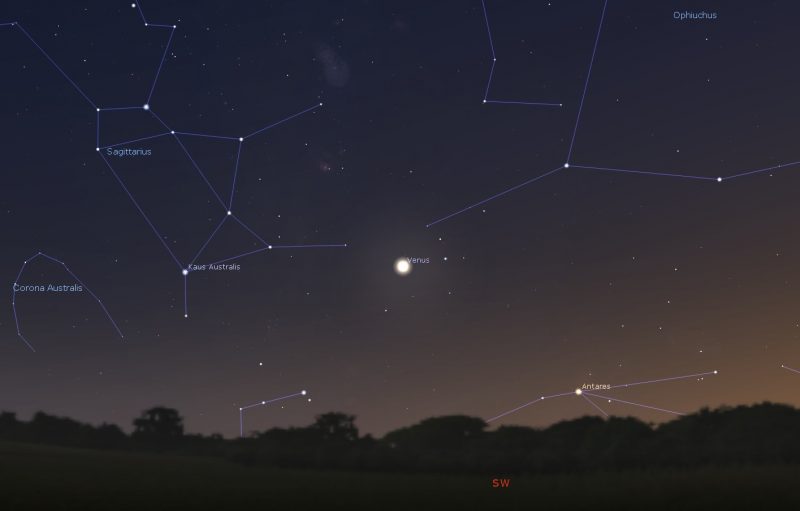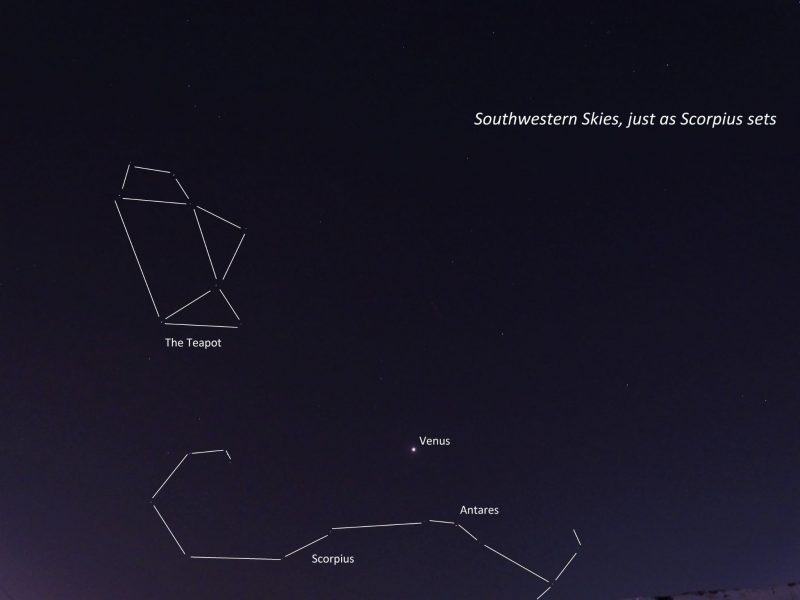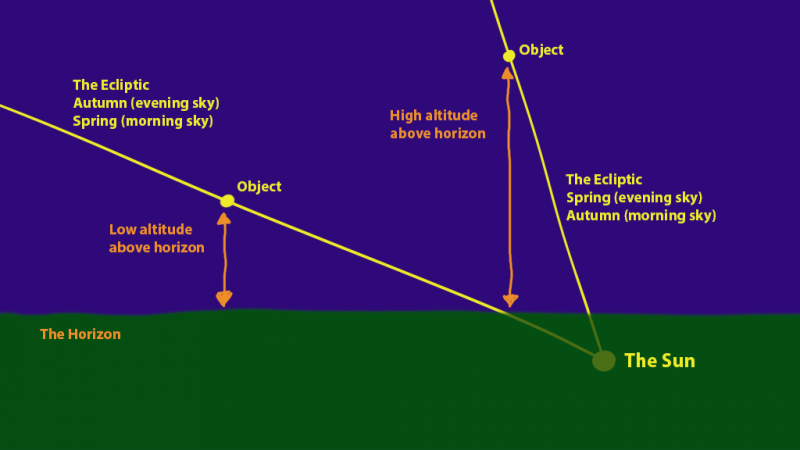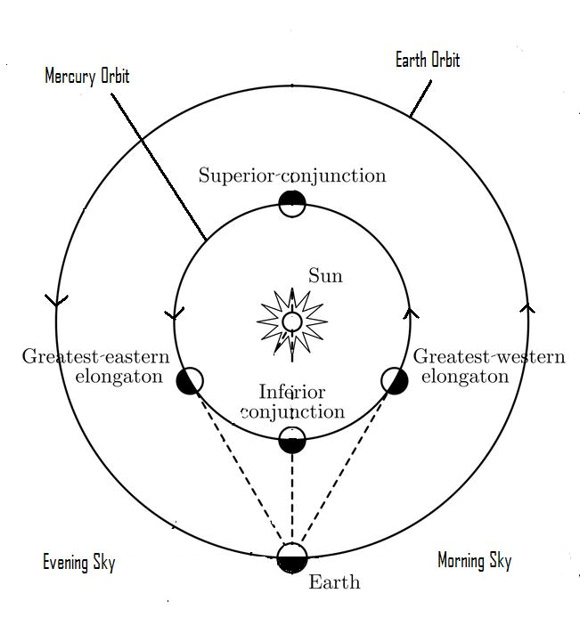
Venus at greatest elongation
Venus is the brightest planet seen from Earth. And it’ll be a beautiful and interesting world to watch through the end of 2021. Look west after sunset for Venus. You can miss it. It’s dazzling! That’s even though, from the Northern Hemisphere, the autumn angle of the ecliptic keeps Venus to the left of the sunset point, not high above the horizon. From the Southern Hemisphere, Venus is gloriously high above the sunset all month. And, for all of us, Venus will reach its greatest elongation, its farthest point from the sun on the sky’s dome, on October 29. At greatest elongation, Venus will stretch 47 degrees from the sun, its maximum possible distance.
Venus ranks as the 3rd-brightest celestial body to light up the heavens, after the sun and moon. On any evening between now and late December, it’ll be the first “star” to pop into view. Venus is currently getting brighter as the weeks pass. Its greatest illuminated extent – heralding its time of greatest brilliancy for this evening apparition – will take place in early December 2021.
By then, Venus will appear much closer to the sunset, even lower in the sky, an eerie bright light. UFO sightings will increase around that time!
All in all, Venus will make quite an impression before 2021 ends, for all of us on Earth.

How to view Venus at greatest elongation
Seeing Venus at greatest elongation is easy. Just look west after sunset – to the left of the sunset from the Northern Hemisphere – straight above the sunset from the Southern Hemisphere. You can miss the brightest planet.
Venus is so bright that some sharp-eyed people have been known to see it in a daytime sky. That’ll happen most often around early December, when Venus is at its brightest. But it’s possible now, too. Most of us, though, will have to wait until after the sun goes down to see this blazing planet. Then watch out! Venus’ brightness and distance from the sun in late October 2021 will dazzle you.
Venus comes to its October 29 greatest elongation in front of the constellation Ophiuchus the Serpent Bearer. Ophiuchus has a reputation as the 13th constellation of the zodiac because the sun, moon and planets all sometimes pass within its boundaries.

Venus setting times
As mentioned above, for this October 2021 elongation, the farther north you live, the shorter the time Venus will stay out after sunset. And the farther south you live, the longer. Here is the approximate setting time for Venus at various latitudes:
60 degrees north latitude (Anchorage, Alaska, for example): Venus sets about 30 minutes after sunset (and is only about a degree above the horizon)
40 degrees north latitude (Denver, Colorado, for example): Venus sets about 2 and a half hours after sunset
Equator, 0 degrees latitude (Singapore, for example): Venus sets about 3 hours and 15 minutes after sunset
40 degrees south latitude (Wellington, New Zealand, for example): Venus sets about 4 hours after sunsetWant more specific information? Click here for a sky almanac.
Spring versus fall elongations
Springtime elongations of Venus (or Mercury) are always best. At such times, Venus is always above the sunset. Autumn elongations aren’t as glorious because then Venus’ distance from the sun is mostly sideways, along the horizon. Why the difference?
The angle of the ecliptic is what determines how high or low Venus is after sunset. That angle is low to the horizon in autumn and steep in spring. The sun, moon and planets all travel on the ecliptic. So, when a greatest eastern elongation happens in spring, the planet appears farther above the horizon and is visible for longer in a dark sky. When a greatest eastern elongation happens in the fall, the planet is closer to the horizon and appears for a shorter time in a dark sky. That’s what’s happening for us in the Northern Hemisphere at this October 2021 greatest elongation.
The reverse is true for greatest western elongations, or when an inner planet is farthest from the sun in the morning. For a morning elongation of Venus, the ecliptic makes its steepest angle to the horizon at the autumn equinox, and its shallowest angle to the horizon at the spring equinox.
As the angle of the ecliptic to the horizon gets wider as we move away from Northern Hemisphere’s fall equinox, Venus will appear higher above the horizon. The planet reaches its highest altitude on 2021 evenings on December 9. That’s shortly after Venus will reach its greatest illuminated extent (greatest brilliancy) on December 3.
So keep watching Venus. The view is only going to get better!

Bottom line: At greatest eastern elongation on October 29, 2021, Venus is as far from the sun as it will be for this evening apparition. It’ll be a prime viewing target after sunset this month, and an interesting planet to watch between now and the end of the year. Venus appears better the farther south you live.
The post Venus at greatest elongation on October 29 first appeared on EarthSky.
from EarthSky https://ift.tt/3vGRUku

Venus at greatest elongation
Venus is the brightest planet seen from Earth. And it’ll be a beautiful and interesting world to watch through the end of 2021. Look west after sunset for Venus. You can miss it. It’s dazzling! That’s even though, from the Northern Hemisphere, the autumn angle of the ecliptic keeps Venus to the left of the sunset point, not high above the horizon. From the Southern Hemisphere, Venus is gloriously high above the sunset all month. And, for all of us, Venus will reach its greatest elongation, its farthest point from the sun on the sky’s dome, on October 29. At greatest elongation, Venus will stretch 47 degrees from the sun, its maximum possible distance.
Venus ranks as the 3rd-brightest celestial body to light up the heavens, after the sun and moon. On any evening between now and late December, it’ll be the first “star” to pop into view. Venus is currently getting brighter as the weeks pass. Its greatest illuminated extent – heralding its time of greatest brilliancy for this evening apparition – will take place in early December 2021.
By then, Venus will appear much closer to the sunset, even lower in the sky, an eerie bright light. UFO sightings will increase around that time!
All in all, Venus will make quite an impression before 2021 ends, for all of us on Earth.

How to view Venus at greatest elongation
Seeing Venus at greatest elongation is easy. Just look west after sunset – to the left of the sunset from the Northern Hemisphere – straight above the sunset from the Southern Hemisphere. You can miss the brightest planet.
Venus is so bright that some sharp-eyed people have been known to see it in a daytime sky. That’ll happen most often around early December, when Venus is at its brightest. But it’s possible now, too. Most of us, though, will have to wait until after the sun goes down to see this blazing planet. Then watch out! Venus’ brightness and distance from the sun in late October 2021 will dazzle you.
Venus comes to its October 29 greatest elongation in front of the constellation Ophiuchus the Serpent Bearer. Ophiuchus has a reputation as the 13th constellation of the zodiac because the sun, moon and planets all sometimes pass within its boundaries.

Venus setting times
As mentioned above, for this October 2021 elongation, the farther north you live, the shorter the time Venus will stay out after sunset. And the farther south you live, the longer. Here is the approximate setting time for Venus at various latitudes:
60 degrees north latitude (Anchorage, Alaska, for example): Venus sets about 30 minutes after sunset (and is only about a degree above the horizon)
40 degrees north latitude (Denver, Colorado, for example): Venus sets about 2 and a half hours after sunset
Equator, 0 degrees latitude (Singapore, for example): Venus sets about 3 hours and 15 minutes after sunset
40 degrees south latitude (Wellington, New Zealand, for example): Venus sets about 4 hours after sunsetWant more specific information? Click here for a sky almanac.
Spring versus fall elongations
Springtime elongations of Venus (or Mercury) are always best. At such times, Venus is always above the sunset. Autumn elongations aren’t as glorious because then Venus’ distance from the sun is mostly sideways, along the horizon. Why the difference?
The angle of the ecliptic is what determines how high or low Venus is after sunset. That angle is low to the horizon in autumn and steep in spring. The sun, moon and planets all travel on the ecliptic. So, when a greatest eastern elongation happens in spring, the planet appears farther above the horizon and is visible for longer in a dark sky. When a greatest eastern elongation happens in the fall, the planet is closer to the horizon and appears for a shorter time in a dark sky. That’s what’s happening for us in the Northern Hemisphere at this October 2021 greatest elongation.
The reverse is true for greatest western elongations, or when an inner planet is farthest from the sun in the morning. For a morning elongation of Venus, the ecliptic makes its steepest angle to the horizon at the autumn equinox, and its shallowest angle to the horizon at the spring equinox.
As the angle of the ecliptic to the horizon gets wider as we move away from Northern Hemisphere’s fall equinox, Venus will appear higher above the horizon. The planet reaches its highest altitude on 2021 evenings on December 9. That’s shortly after Venus will reach its greatest illuminated extent (greatest brilliancy) on December 3.
So keep watching Venus. The view is only going to get better!

Bottom line: At greatest eastern elongation on October 29, 2021, Venus is as far from the sun as it will be for this evening apparition. It’ll be a prime viewing target after sunset this month, and an interesting planet to watch between now and the end of the year. Venus appears better the farther south you live.
The post Venus at greatest elongation on October 29 first appeared on EarthSky.
from EarthSky https://ift.tt/3vGRUku

Aucun commentaire:
Enregistrer un commentaire